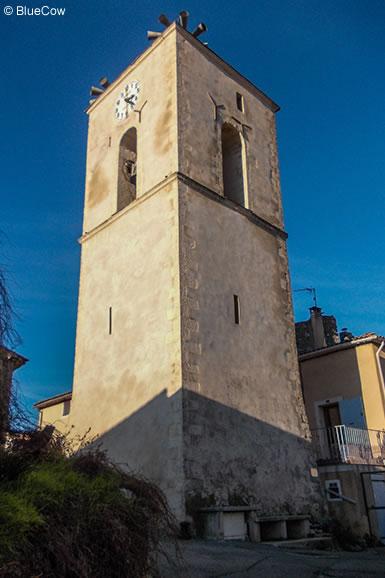

Once upon a time in the Aigues Valley, on the southern side of the Luberon, a small castle, or castellum, with its round keep and defensive walls reigned over an agricultural territory. In 1253, the Jourdan family, the new lords of that castle and its lands, founded a village that they would call La Bastide-des-Jourdans. Sometimes, on a misty day, the village's buildings are shrouded in a mystical air...
Straight away, like all good Christians of the time, in 1274 the lords had a chapel built, the Saint-Lambert chapel. Then they built the church and the ramparts. Succeeding the Jourdans, in the 14th century the families of Riez added a square tower and living quarters to the castle. It was then in the 16th century that the castle stood before the world in its finished, more beautiful form. Only to be sacked and pillaged during the French Revolution. Abandoned, it fell to ruins...

The chateau at La Bastide des Jourdans

Notre-Dame Saint-Pierre aux Liens Church

Notre-Dame de Consolation Church

Saint-Marc Chapel

La Bastide des Jourdans, small village on the southern side of the Luberon

But, never really finding itself at the turning points of history, La Bastide-des-Jourdans managed to remain a peaceful little village that has kept all the elements of its past.
A century before the foundation of the village itself, the Knights Templar had established a Commandery here and the ruins are still visible on the Limaye farm. Their chapel of Saint-Marc has the particularity of having been “westernised”, that is to say, its apse was placed towards the west. There is a very pretty bell above its roof. Their second domain, also with a chapel, was in the place called Notre-Dame de la Cavalerie.
But the prettiest chapel can be found next to the old village: Notre-Dame de la Consolation, surmounted by a bell, even prettier than the one mentioned above, and with a cross standing proudly in front of it.
A little off from the old village, the 13th century church, enlarged and altered in the 15th and 17th centuries, has become the Parish Church of Saint-Pierre.
Let's go through one of the two old remaining gates in the 14th century walls to discover this little medieval village.
The castle's original square tower and round keep still stand. The ruins had been purchased at the end of the 19th century and restored to the present-day shape (which is believed to be faithful to the original).
Notice also the 18-metre high belfry surmounted by a campanile. Built between 1620 and 1632 on a small hillock, it holds the parish bells and the town clock.
And fountains there are as well: the Jeanne fountain built around 1793 with a magnificent statue, the fountain with tall column on the Place de la République, the Basse fountain, which is a washhouse with three basins, and also the basin at the Porte Fiol gate.
And a river runs through it: the Eze, a confluent of the Durance river, has its source in La Bastide-des-Jourdans.
And if you're thirsty, the village has a couple of quite pleasant cafés.
In the area around Bastide-des-Jourdans
Grambois, 5 km away, very picturesque and well-preserved Provençal medieval village. The film La Gloire de mon Père by Marcel Pagnol was filmed here.
Manosque: Traditional Provençal village with a beautiful medieval town centre to explore.
Ansouis: Magnificent village of the Luberon, very picturesque with its medieval houses.
Cucurron: Fortified Provençal village set in the exceptional landscape of the Luberon.

Fontaine de la Jeanne

Low fountain or Fontvieille

Porte de Fiol gate and the teenager

The Eze river going through the village

Fountain built in 2898

House door
Art of living
Gastronomy, markets of Provence, regional products, Christmas traditions, celebrities of Provence....